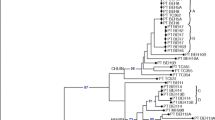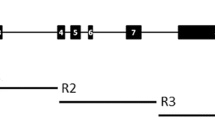Abstract
Japanese rice (Oryza sativa L.) cultivars that are strictly used for the brewing of sake (Japanese rice wine) represent a unique and traditional group. These cultivars are characterized by common traits such as large grain size with low protein content and a large, central white-core structure. To understand the genetic diversity and phylogenetic characteristics of sake-brewing rice, we performed amplified fragment length polymorphism and simple sequence repeat analyses, using 95 cultivars of local and modern sake-brewing rice together with 76 cultivars of local and modern cooking rice. Our analysis of both nuclear and chloroplast genome polymorphisms showed that the genetic diversity in sake-brewing rice cultivars was much smaller than the diversity found in cooking rice cultivars. Interestingly, the genetic diversity within the modern sake-brewing cultivars was about twofold higher than the diversity within the local sake-brewing cultivars, which was in contrast to the cooking cultivars. This is most likely due to introgression of the modern cooking cultivars into the modern sake-brewing cultivars through breeding practices. Cluster analysis and chloroplast haplotype analysis suggested that the local sake-brewing cultivars originated monophyletically in the western regions of Japan. Analysis of variance tests showed that several markers were significantly associated with sake-brewing traits, particularly with the large white-core structure.






Similar content being viewed by others
References
Aggarwal RK, Brar DS, Nandi S, Huang N, Khush GS (1999) Phylogenetic relationships among Oryza species revealed by AFLP markers. Theor Appl Genet 98:1320–1328
Akagi H, Yokozeki Y, Inagaki A, Fujimura T (1997) Highly polymorphic microsatellites of rice consist of AT repeats, and a classification of closely related cultivars with these microsatellite loci. Theor Appl Genet 94:61–67
Ashikawa I, Fukuta Y, Tamura K, Yagi T (1999) Application of AFLP technique that uses non-radioactive fluorescent primers to the detection of genetic diversity in Japanese rice cultivars and cloning of DNA sequences derived from an Indica genome. Breed Sci 49:225–231
Botstein D, White RL, Sholnick M, Davis RW (1980) Construction of a genetic linkage map in man using restriction fragment length polymorphisms. Am J Hum Genet 32:314–331
Chang T (1976) The origin, evolution, cultivation, dissemination, and diversification of Asian and African rices. Euphytica 25:425–441
Chen X, Temnykh S, Xu Y, Cho YG, McCouch SR (1997) Development of a microsatellite framework map providing genome-wide coverage in rice (Oryza sativa L.). Theor Appl Genet 95:553–567
Innan H, Terauchi R, Kahl G, Tajima F (1999) A method for estimating nucleotide diversity from AFLP data. Genetics 151:1157–1164
Ishii T, McCouch SR (2000) Microsatellites and microsynteny in the chloroplast genomes of Oryza and eight other Gramineae species. Theor Appl Genet 100:1257–1266
Ishii T, Xu Y, McCouch SR (2001) Nuclear- and chloroplast-microsatellite variation in A-genome species of rice. Genome 44:658–666
Kato T (1989) Diallel analysis of grain size of rice (Oryza sativa L.). Jpn J Breed 39:39–45
Kubo TA, Yoshimura A, Iwata N (1998) Trial construction of molecular linkage map of Japonica rice. J Fac Agric Kyushu Univ 43:95–101
Mackill DJ, Zhang Z, Redona ED, Colowit PM (1996) Level of polymorphism and genetic mapping of AFLP markers in rice. Genome 39:969–977
Maheswaran M, Subudhi PK, Nandi S, Xu JC, Parco A, Yang DC, Huang N (1997) Polymorphism, distribution, and segregation of AFLP markers in a doubled haploid rice population. Theor Appl Genet 94:39–45
Mano Y, Kawasaki S, Takaiwa F, Komatsuda T (2001) Construction of a genetic map of barely (Hordeum vulgare L.) cross ‘Azumamugi’ × ‘Kanto Nakate Gold’ using a simple and efficient amplified fragment length polymorphism system. Genome 44:284–292
Miyashita NT, Kawabe A, Innan H (1999) DNA variation in the wild plant Arabidopsis thariana revealed by amplified fragment length polymorphism analysis. Genetics 152:1723–1731
Murray MG, Thompson WF (1980) Rapid isolation of high molecular weight plant DNA. Nucleic Acids Res 8:4321–4325
Nei M (1987) Molecular evolutionary genetics. Columbia University Press, New York
Nei M, Li WH (1979) Mathematical model for studying genetic variation in terms of restriction endonucleases. Proc Natl Acad Sci USA 76:5296–5273
Okamoto M (1994) Studies on effect of chemical components on stickiness of cooked rice and their selection method for breeding. Bull Chugoku Agric Exp Stn 14:1–68
Olufowote JO, Xu Y, Chen X, Park WD, Beachell HM, Dilday RH, Goto M, McCouch SR (1997) Comparative evaluation of within-cultivar variation of rice (Oryza sativa L.) using microsatellite and RFLP markers. Genome 40:370–378
Panaud O, Chen X, McCouch SR (1996) Development of microsatellite markers and characterization of simple sequence length polymorphism (SSLP) in rice (Oryza sativa L.). Mol Gen Genet 252:597–607
Saitou N, Nei M (1987) The neighbor-joining method: a new method for reconstructing phylogenetic trees. Mol Biol Evol 4:406–425
Sneath PHA, Sokal RR (1973) Numerical taxonomy. WH Freeman, San Francisco
Takeda K (1990) Inheritance of grain size and its implications for rice breeding. In: Proceedings of the Second International Rice Genetics Symposium. IRRI, Manila, pp 181–189
Takita T (1985) Inheritance of grain size and the relationship between grain size and other characters in rice. Bull Natl Agric Res Center 3:55–71
Tanksley SD, McCouch SR (1997) Seed banks and molecular maps: unlocking genetic potential from the wild. Science 277:1063–1066
Tauz D (1989) Hypervariability of simple sequences as a general source of polymorphic DNA markers. Nucleic Acids Res 17:6463–6471
Temnykh S, Park WD, Ayres N, Cartinhour S, Hauck N, Lipovich L, Cho YG, Ishii T, McCouch SR (2000) Mapping and genome organization of microsatellite sequences in rice (Oryza sativa L.). Theor Appl Genet 100:697–712
Vos P, Hogers R, Bleeker M, van de Lee T, Hornes M, Frijters A, Pot J, Peleman J, Kuiper M, Zabeau M (1995) AFLP: a new technique for DNA fingerprinting. Nucleic Acids Res 23:4407–4414
Wu KS, Tanksley SD (1993) Abundance, polymorphism and genetic mapping of microsatellites in rice. Mol Gen Genet 241:225–235
Yang GP, Saghai Maroof MA, Xu CG, Zhang Q, Biyashev RM (1994) Comparative analysis of microsatellite DNA polymorphism in landraces and cultivars of rice. Mol Gen Genet 245:187–194
Yoshida S, Ikegami M, Kuze J, Sawada K, Hashimoto Z, Ishii T, Nakamura C, Kamijima O (2002) QTL analysis for plant and grain characters of sake-brewing rice using a doubled haploid population. Breed Sci 52:309–317
Yu SB, Xu WJ, Vijayakumar CHM, Ali J, Fu BY, Xu JL, Jiang YZ, Marghirang R, Domingo J, Aquino C, Virmani SS, Li ZK (2003) Molecular diversity and multilocus organization of the parental lines used in the international rice molecular breeding program. Theor Appl Genet 108:131–140
Zhu J, Gale MD, Quarrie S, Jackson MT, Bryan GJ (1998) AFLP markers for the study of rice biodiversity. Theor Appl Genet 96:602–611
Acknowledgements
We thank Dr. Kazuo Kawano, Food Resources Education and Research Center, Kobe University, for his critical comments. The work was supported in part by a grant-in-aid from the Ministry of Education, Culture, Sports, Science and Technology of Japan (to CN, no. 11794003, 1638006). Contribution No. 151 from the Laboratory of Plant Genetics, Kobe University.
Author information
Authors and Affiliations
Corresponding author
Additional information
Communicated by J. Dvorak
Rights and permissions
About this article
Cite this article
Hashimoto, Z., Mori, N., Kawamura, M. et al. Genetic diversity and phylogeny of Japanese sake-brewing rice as revealed by AFLP and nuclear and chloroplast SSR markers. Theor Appl Genet 109, 1586–1596 (2004). https://doi.org/10.1007/s00122-004-1794-6
Received:
Accepted:
Published:
Issue Date:
DOI: https://doi.org/10.1007/s00122-004-1794-6




